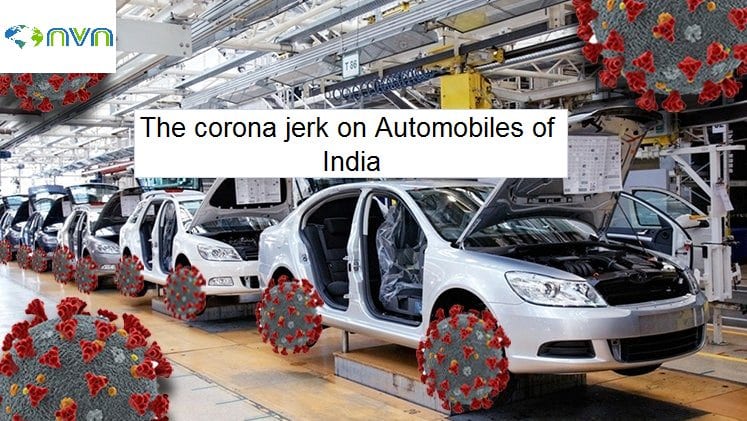Auto
The corona jerk on Automobiles of India

The ever booming Indian automobile sector is facing corona bumps with striving for space and speed. The recent times was an unparalleled situation in the history of the Indian automobile industry. Never before had it witnessed a zero-production and zero-sales month since the dawn of automobile manufacturing in the country. Industry representatives have been continuously adjuring the government to enunciate explicit and immediate measures to facilitate them thrive the current phase and speed up a revival that they are hoping for when the COVID-19 scare settles.
But India was not the same few months ago. India became the fourth largest auto market in 2018 with sales increasing at 8.3 per cent year-on-year to 3.99 million units. It was the seventh largest manufacturer of commercial vehicles in 2018. The Two-wheeler segment dominates the market in terms of volume owing to a growing middle class and a young population. Moreover, the burgeoning interest of the companies in exploring the hinterland markets, further supported the growth of the sector.
India is also a prominent auto exporter and has strong export growth expectations for the near future. Automobile exports grew 14.50 per cent during Financial Year 2019. It is expected to grow at a CAGR of 3.05 per cent during 2016-2026. In addition, several initiatives by the Government of India and the major automobile players in the Indian market are expected to make India a leader in the two-wheeler and four-wheeler market in the world by 2020.
Overall domestic automobiles sales increased at 6.71 per cent CAGR between Financial Year 13-19 with 26.27 million vehicles getting sold in Financial Year 2019. Domestic automobile production increased at 6.96 per cent CAGR between Financial Year 13-19 with 30.92 million vehicles manufactured in the country in FY’19.
In Financial Year 2019, year-on-year growth in domestic sales among all the categories was recorded in commercial vehicles at 17.55 per cent followed by 10.27 per cent year-on-year growth in the sales of the three-wheelers. Automobile exports grew 14.50 per cent year-on-year during 2019, while during April-December 2019, overall export increased by 3.9 per cent.
Premium motorbike segment sales in India recorded seven-fold jump in domestic sales reaching 13,982 units during April-September 2019. The sale of luxury cars stood between 15,000 to 17,000 in first six months of 2019. Sales of electric two-wheelers are forecasted to have crossed 55,000 vehicles in 2017-18.
Going by the trend the automobile honchos have invested heavily to tap the potential of the Indian market. Several auto makers have started investing heavily in various segments of the industry during the last few months. The industry has fascinated Foreign Direct Investment (FDI) worth US$ 23.89 billion during the period April 2000 to December 2019, according to data released by Department for Promotion of Industry and Internal Trade (DPIIT).
In January 2020, Tata Auto Comp Systems, the auto-component arm of the Tata Group entered a joint venture with Beijing-based Prestolite Electric to enter the electric vehicle (EV) components market. Similarly in December 2019, Force Motors planned to invest Rs 600 crore (US$ 85.85 million) in order to develop two new models over the next two years and Morris Garages (MG), a British automobile brand announced plans to invest Rs 3,000 crore (US$ 429.25 million) more into India. German car maker Audi plans to launch nine all-new models including Sedans and SUVs along with futuristic e-tron electric vehicle (EV) by the end of 2020 in India.
Apart from that Hyundai is planning to invest US$ 1 billion in India by 2020. SAIC Motor has also announced to invest US$ 310 million in India. Mercedes Benz has increased the manufacturing capacity of its Chakan Plant to 20,000 units per year, highest for any luxury car manufacturing in India.
This investment was obvious as our auto penetration expected to reach 72 vehicles per 1000 people by 2025 and at the same time India accounts for 40% of total $31 billion of global engineering and R&D spend. 8% of the country’s R&D expenditure is in the automotive sector. The automobile industry is supported by various factors such as availability of skilled labor at low cost, robust R&D centers and low-cost steel production. The industry also provides great opportunities for investment and direct and indirect employment to skilled and unskilled labor. Indian automobile industry (including component manufacturing) is expected to reach Rs 16.16-18.18 trillion (US$ 251.4-282.8 billion) by 2026.
With the stagnant fuel price hovering around in the economy and with a slew of measures by the Government and recently announced economic package of the Rs 20 lakh crore that the PM asserted will provide support to the middle class and workers in the unorganized sectors will create a self reliant supply chain in the country and may infuse some life to the automotive industry.






























